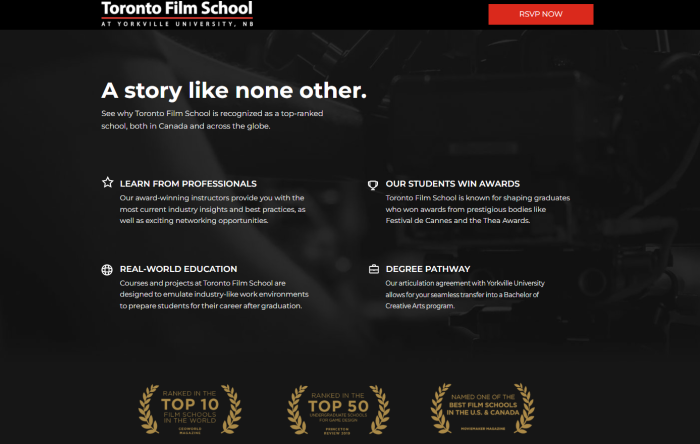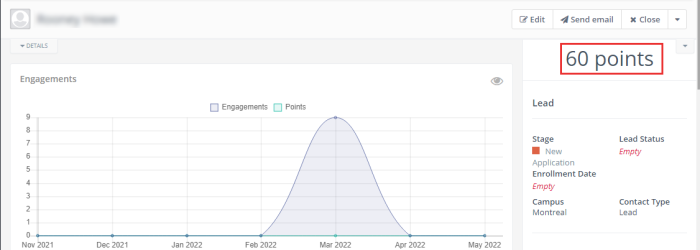Nowadays, the enrollment journey starts online. This means that prospective students, parents, and other stakeholders are relying on online research to learn more about your school. By using inbound marketing for schools, you can transform that moment into an opportunity to provide your prospects with more value—all while standing apart from your competition.
When applied correctly, an inbound marketing strategy can help you attract prospective students by appealing to their interests and capturing their attention. A wide range of techniques can be used to engage and delight your prospects, securing their loyalty to your school and driving conversions. As a result, you can help potential prospects become dedicated fans of your school and, ultimately, enrolled students.
From blogs and social media posts to landing pages and email messages, inbound marketing equips your school with the tools it needs to connect with its prospects and grow. Here’s a breakdown of the top inbound marketing tips in education that you can use to level up your recruitment efforts.
Understanding Inbound Marketing for Schools
As you begin to try new marketing approaches, you may wonder: does inbound marketing work in education? The answer is a resounding yes!
At its core, inbound marketing is about creating meaningful and valuable connections with your audience. It’s also about boosting your school’s growth by providing relevant information that resonates with your prospects. Simply put, it centres on a “Flywheel” business model—which focuses on three stages as the driving force behind your growth:
- The Attract Stage
- The Engage Stage
- The Delight Stage
These different stages can naturally align with your school’s admissions funnel, applying to top-of-the-funnel (TOFU), middle-of-the-funnel (MOFU), and bottom-of-the-funnel (BOFU) marketing strategies. This way, you can create a consistent approach that delivers positive experiences throughout the enrollment journey and develop a marketing plan to increase student enrollment. By optimizing the background of your prospects, you can then build momentum and support your school’s business objectives.
Looking for a way to strengthen these efforts? Our team of industry experts can help your school develop a strong inbound marketing strategy that delivers results.
Transforming Prospects into Website Visitors and Social Media Followers
To connect with your prospects, you must understand who they are and what they want. Student personas are a great way to accomplish this step. These semi-fictional documents indicating your prospects’ backgrounds, motivations, and concerns can guide you as you develop your strategy. These personas significantly influence messaging and content, becoming the backbone of inbound marketing for schools.
Since the search for the right school is done online via search engines and social media, you’ll want to ensure that your inbound marketing efforts focus on these spaces. This means improving your discoverability by enhancing your content strategy, social media presence, and website search engine ranking.
Adopting an SEO-Driven Content Marketing Strategy for Your School
If you’re seeking to define the required content strategy for inbound marketing, you should look into creating SEO-driven content. Search engine optimization (SEO) is a key approach that allows you to align an online user’s search intent with your web content. This way, prospects interested in the programs you offer or the subjects you teach can easily find you and learn more about your school.
By embracing relevant and creative blog topics and applying SEO best practices, you can generate better website traffic. This allows you to highlight your unique selling points—sharing information about your community and offerings in a way that compels prospects to engage further with your school’s messaging and brand.
Taking this approach in your inbound marketing strategy can also help you target high-gain keywords—phrases your prospects are likely using to find the right school. As you conduct your keyword research, you can identify effective ways to appeal to your audience and draw them into your content.
Example: In a blog post featuring the accomplishments of a current student, Business School Lausanne focuses on the keyword “BBA Degree.” The blog post includes this keyword in its title and in a subheading further down the page. Optimizing the content for a specific keyword while also spotlighting students in this way is an effective content strategy for inbound marketing.

Source: Business School Lausanne
It’s worth stressing that a content strategy for inbound marketing is not limited to blog content. Your school can explore different media types, including podcasts and videos. This is where high-fidelity content comes in, allowing you to stand out in a competitive market and more effectively attract your prospects.
Example: Wilfrid Laurier University dedicates time and effort to curate valuable video content for its community. To appeal to prospects, this high-fidelity content expands to include a domestic video series along with university research, campus spotlights, event highlights, and other highly relevant content:

Source: Wilfrid Laurier University YouTube
Boosting Your Engagement on Social Media with Inbound Marketing for Schools
Social media is a core component of inbound marketing in education, particularly as the number of social media users continues to rise. In fact, research done in April 2023 shows that 4.8 billion people worldwide now use social media. Sharing content and being active on social channels can make your school seem more approachable, drawing prospects into a conversation that moves them further along their enrollment journey.
One way to boost engagement on social media is to appeal to your prospects’ interests and motivations using your student personas. Not only would this allow you to create relevant and compelling content, but it can also be a way for your school to show how in tune it is with its audience. Combining this approach with a strong understanding of hashtags and social media algorithms can help you generate better results.
Example: In a tweet, Rhodes Wellness College uses a hashtag to share a link to one of its recent blog post with a wider audience. Here, the hashtag “#RelationshipCounselling” is relevant to the content being shared, appealing to prospects who already have an interest in this topic.

Source: Rhodes Wellness College Twitter
Most schools ask the following question: how do I market my private school? This all hinges on choosing the right platform—ensuring your content is released on the platform that matters most to your audience. For instance, career colleges may do well to focus their efforts on LinkedIn, a platform geared towards professionals, while K-12 schools can turn to Facebook to better appeal to parents.
Example: In a Facebook post, Kells Academy showcases the valuable lessons that their middle school students have learned, motivating families to register for their open house event:

Source: Facebook
Presenting engaging content in this way is a practical approach to inbound marketing for private schools. Through these efforts, school advertisers can better market private schools and connect with interested families.
Embracing Calls to Action and Driving Conversions for Better Student Recruitment
It’s no secret that effective calls to action (CTAs) bring in results. They invite prospects to complete an action you want them to take, leading to conversions that move them further in the admissions funnel. With every desirable effort taken, your school gets an even bigger chance of converting potential prospects into enrolled students.
Different elements go into drafting these CTAs, typically involving personalization or a sense of urgency. Through action-oriented language, prospects are encouraged to take the initiative—making them crucial to every campaign in inbound marketing for schools. As a result, you’ll use them in a wide range of marketing activities, from email messages and web content to landing pages and lead generation forms.
Using Landing Pages to Connect with Your School’s Prospects
Landing pages can best be described as standalone pages created for a specific campaign with the intent to convert visitors. Because of this, landing pages are not built as part of a school’s existing website. They typically don’t contain a navigation bar or menu system. Instead, the page is uniquely designed to focus the visitor’s attention and guide them toward a single and clear CTA. This CTA works as a marketing strategy to attract students and allows schools to generate leads and push prospects closer to enrollment.
When it comes to developing a landing page for your school, you need to consider different components. This includes great copy, compelling images or videos, and a pleasant user interface. Inspecting successful inbound marketing examples that feature landing pages can help you with the process of developing your own.
Example: The Toronto Film School showcases an eye-catching video at the top of this landing page, highlighting only key bullet points along with a single CTA throughout the page. In doing so, the school makes it easy for visitors to glance through the content, make a quick decision, and complete the desired action:


Capturing Leads with Forms in Your School’s Inbound Marketing Strategy
Another key feature that’s crucial to an effective landing page is a well-structured form. Forms play a big role here, ultimately boosting your lead generation efforts. A good form is clear and concise, making it painless for prospects to provide your school with key information—such as their contact details.
Example: Kelvinside Academy presents an easy-to-follow form on its website to enable prospective students and families to reach out. The form asks users to provide their name, email address, and message while allowing them to opt into receiving additional marketing emails from the school. Offering this option in the form is one way to support inbound marketing for independent schools.

Source: Kelvinside Academy
Once you’ve gathered a lead’s information, you can add this data to your school’s customer relationship management (CRM) software. Through this software, you can begin marketing to students, nurturing and scoring your leads.
By using HEM’s proprietary education-centered CRM, you can maximize your inbound marketing efforts while streamlining your lead management. The software makes it easy for school marketers to score leads based on personalized criteria, as shown below:

It can also be used to nurture these leads via email marketing. This way, you can send your prospects direct messages that foster a sense of loyalty to your school’s brand while also evaluating how likely they are to convert and become enrolled students.
Closing Prospects by Relying on Direct Email Marketing Campaigns
According to HubSpot, 77% of marketers have noticed a boost in email engagement over the past year. That’s because email equips you with a direct platform for communicating with prospects, unlike other digital marketing channels. Not only can it be used to initiate first contact, but it can also be a way to maintain subsequent interactions. Since it takes more than one interaction to close prospects, using email as part of inbound marketing for schools can help you push your way through the competition—becoming top of mind.
Through automated email workflows, schools can better reach specific prospects and appeal to their needs in the admissions funnel. For this to work best, it’s important to consider your goals and your audience’s. Here, audience segmentation comes in handy, helping you cultivate the right message for the right audience at the right time.
Focusing on lead nurturing in these workflows can be one way to increase your inbound marketing success. For instance, you can begin the email chain after prospects have filled out a form and submitted an inquiry. From that moment onwards, they can receive carefully curated emails that motivate them to take further action. This includes everything from admissions tips and student interviews to upcoming events and application deadlines. After this step, prospects will be more likely to take the plunge and convert closer to the bottom of the funnel. Key actions they can take can range from attending a campus tour to scheduling an interview with admissions—ultimately bringing them closer to enrollment.
Example: Through an email newsletter, Bishop’s University invites its prospects to attend an Open House event on campus and online for those who can’t make it. The email highlights the value of the event, enticing engaged and interested prospects to register and more deeply commit to the school.

Combining marketing automation and email messaging with other inbound efforts can improve your student recruitment strategy. In addition to attracting and engaging students, these combined techniques will allow you to close prospects more easily and delight them moving forward.
Revisiting Your School’s Analytics for Insights on How to Improve
Improving your efforts should be a continuous goal, significantly as student behaviours and platform algorithms change. You’ll want to be sure to use industry best practices, all while keeping your persona’s best interest in mind—even as it evolves. For this reason, your inbound marketing analytics become invaluable.
By analyzing inbound marketing results in education, you can learn which channels and content formats perform best on your website or social media accounts. You can also determine where most of your traffic comes from, how interested prospects are in your content, and more.
By setting up Google Analytics 4 and monitoring key metrics—including traffic growth, search engine rankings, and conversions—you can make the necessary adjustments to optimize your student recruitment strategy. Taking the time to review inbound marketing for schools in this way thoroughly can help you develop a blueprint for your school’s success.







